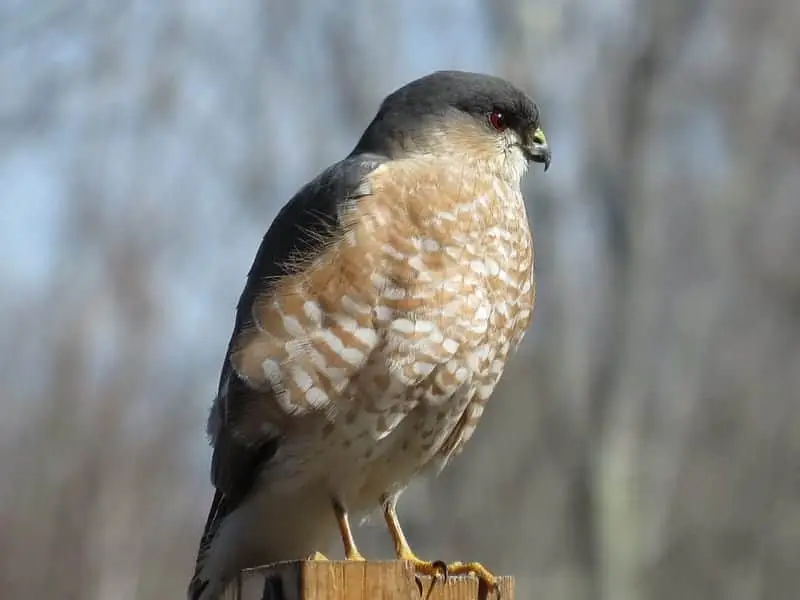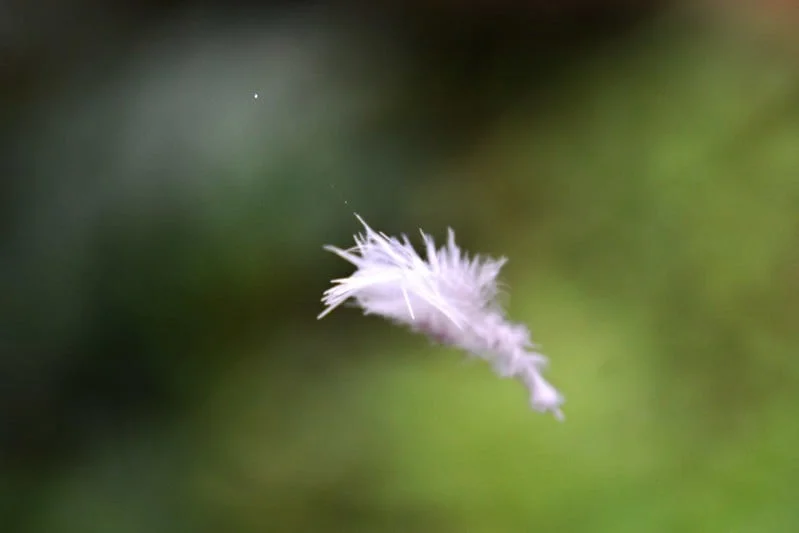
In Indiana, there are 7 different species of hawk that you may encounter.
Table of Contents
ToggleThese are:
- Cooper’s Hawk
- Red-Tailed Hawk
- Rough-legged Hawk
- Northern Harrier
- Red-Shouldered Hawk
- Broad-winged Hawk
- Sharp-Shinned Hawk
Want to learn more? This book on the Birds of Prey of North America is a fantastic read!
There have also been reported sightings of Swainson’s Hawks, however this data is very thin and may have been a result of misidentification.
Indiana is a state with a largely continental climate, meaning that in Indiana there are cool winters and long, warm summers.
There are 25 different state parks across all of Indiana and 3 different national parks.
These parks are very popular birding spots and there have been many hawk sightings in them and across all areas of the state. Let’s have a look at the hawks that have been seen in the state.
Now that we’ve discussed what hawks can be found in Indiana, let’s have a look at the individual species in some greater detail.
Want to attract birds of prey to your yard? Take a look at our article!
What Hawks can be seen in Indiana?
Table of Contents
1. Sharp-Shinned Hawk

“Sharp-Shinned Hawk” by ‘Dennis Murhpy‘ is licensed under CC BY 2.0
Wingspan
43-56cm
Weight
87-218g
Life Expectancy
3 years
Diet
Robins and Thrushes
The wings are covered in dark brown feathers whilst its underbelly is pale in comparison.
These birds will rarely stay in areas of low cover and will only nest in dense and mature forests if they can.
Sharp-shinned Hawks have a diet that is made up of small species of songbirds and they are classified as pursuit hunters.
During their breeding seasons these birds are a lot less active to reduce their risk of predation from larger species of hawks and raptors.
The breeding pairs of this hawk will only have one brood per season, these broods contain 3-8 eggs and breeding pairs will remain monogamous to one another.
Some of these hawks will reside in Indiana permanently, however others will only move into the state outside of their breeding seasons.
The sightings of this bird are evenly distributed throughout Indiana, but most sightings appear to be in the southern half of the state.
2. Cooper’s Hawk

Wingspan
62-90cm
Weight
330-680g
Life Expectancy
Up to 12 years
Diet
Small Birds, Mice & Squirrels
Cooper’s Hawks have large heads but only a medium sized body.
They have red barred feathers on their bellies and breasts and their backs wings are a slate grey colour.
Whilst these birds prefer nesting in thick forests, they have been seen nesting in leafy suburbs. There have also been reports of these hawks nesting in suburban parks in recent years.
These birds mostly consume small mammals and hunt when in fast and powerful flights.
Males and females of this species will build their nests together after the male has performed a bowing display for her. Not a lot else is known about their breeding behaviours.
You can see Cooper’s hawks in all areas of Indiana, and they are present in the state throughout the whole year.
The sightings of these birds are relatively evenly distributed, but most appear to be in the eastern half of the state.
3. Red-Shouldered Hawk

Wingspan
94-111cm
Weight
486g-774g
Life Expectancy
2 years
Diet
Small mammals, reptiles & amphibians
Red-shouldered Hawks are covered in checked patterns of dark and white feathers.
They have medium-sized bodies, and their underbellies and breasts are covered in warm brown feathers.
Most Red-shouldered Hawks nest in areas close to swamps but you have a chance of seeing them in any areas of dense woodlands.
These hawks mostly consume small mammals and search for their prey by hovering in circles.
Red-shouldered hawks are very territorial birds and have been known to not only attack Great Horned Owls and Crows, but also humans that move too close to their nests.
They become even more territorial during the breeding season. Males of this species have a mating display made up of a series of dives that is referred to as a ‘sky dance’.
These birds are also common in Indiana, being seen throughout the year in the state and having a range that encompasses all regions of the state.
They have been seen very frequently in all areas but have most commonly been sighted in the southern regions of Indiana.
4. Broad-Winged Hawk

“Broad Winged Hawk” by ‘Felipe Uribe‘ is licensed under CC BY 2.0
Wingspan
81-100cm
Weight
265g-560g
Life Expectancy
Up to 20 years
Diet
Small mammals & insects
These hawks are easily identified by the shape of their wide and broad wings, which is where they got their name from.
They have pale coloured bellies and brown feathers that cover their wings and heads.
These hawks will usually reside in woodland areas that are close to bodies of water, but they have also been noted as residents of many types of forest areas.
They prefer to be as far away as they can from human activities and landscapes so you will not see them in urban areas.
Some of these birds will form breeding pairs that stay together for a series of several years whilst others will mate with different individuals each year.
Even if they stay together for several years, breeding pairs will not interact with one another outside of the breeding seasons.
You can see these hawks in all areas of the state, but they can only be seen in the state during their breeding seasons.
These migratory birds have been commonly sighted in all areas but most of the sightings appear to be in the south east of the state.
5. Red-Tailed Hawk

Wingspan
114-133cm
Weight
900-1460g
Life Expectancy
10-15 years
Diet
Small mammals, mice & voles
These birds have pale feathered underwings and bellies, and warm brown feathers make up its tail giving it its red appearance.
Red-tailed hawks have been seen in a large variety of habitats and are most commonly found in areas of open woodlands.
When it comes to their territory, these birds are very defensive and can be very aggressive with other birds that come too close into their nesting areas.
They have been known to get into fights with and chase off other hawks, eagles and certain species of owls.
These hawks are monogamous and will mate for life, however, if one individual passes away then the other will form a new breeding pair in the next year.
These birds are common in the state of Indiana, not only being present in all areas of the state but present throughout the whole year.
They do appear to be more common outside of their breeding seasons and have most commonly been sighted in the northwest of the state.
6. Rough-Legged Hawk

Wingspan
132-138cm
Weight
715-1400g
Life Expectancy
Up to 18 years
Diet
Small rodents
Rough-Legged Hawks are known for their vibrant feather patterns and are usually medium to large in size. They have pale heads and dark bellies with pale tails and dark feathers on the tip.
Rough-Legged Hawks breed in the artic during the summer months and migrate south in winter. After migrating they spend time in open habitats like fields and have also been seen habituation US airports.
They build their nests with a bulky mass of sticks on the cliffsides. Some hawks have been observed using bones to make their nest as well.
The best time to see one of these hawks in Wisconsin is during the winter months. They spend the summer in the artic and return to Wisconsin around September to October.
They leave once again in March. The best time of day to see these hawks is early in the morning, they stay hidden at night and hunt when they wake up.
One of the best places to spot Rough-Legged Hawks is in central Wisconsin, particularly in Waushara county. Their nesting sites will usually be along the edge of swampy woodlands and the edges of forests. You can usually spot them perching high in trees or hovering over open fields.
7. Northern Harrier

Wingspan
120cm
Weight
390g
Life Expectancy
16 years
Diet
Rodents and small birds
This hawk has wings covered in slate and pale grey feathers and a white belly littered with small brown patches of feathers.
These birds usually found in grasslands or wetland areas and will only tend to make their nests in areas of low vegetation.
Northern Harriers most often feast on small mammals such as mice and their hunting skills rely largely on hearing when it comes to detecting prey.
These birds are not monogamous, though most males only mate with one or two individuals per breeding season.
Both males and females become defensive of their nests, males tend to chase away other males whilst the females focus on defending their nests from other females.
Whilst you can only see these birds outside of their breeding seasons in Indiana, they can be seen throughout all areas of the state.
These hawks have been frequently sighted in all areas but the most concentrated sightings have been in the southwest of the state.

More Articles.

North American Birds with Blue Wings (13 Species with Pictures and Sounds)
North America is filled with many wonderful birds with blue wings – in fact, there

What Does It Mean To See a White Feather Fall in your Dreams? (Symbolism and Meaning)
In some cultures, seeing a white feather fall in your dream is a sign of

North American Birds with Brown Wings (22 Species with Pictures and Sounds)
Canada and America are filled with many wonderful birds with brown wings – in fact,

About Us
We are avid bird-watchers who recently retired, allowing us more time to travel the world. Fortunately, we have managed to visit numerous countries around Europe, Asia, and America. Watching and photographing birds has been a passion for many years and we are making the most of the extra time on our hands!

